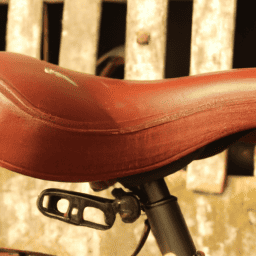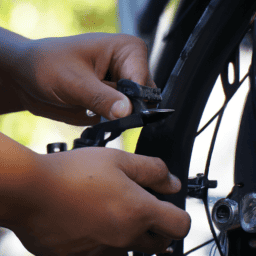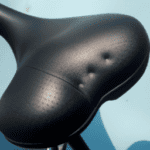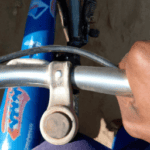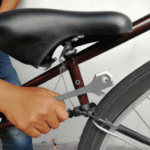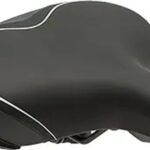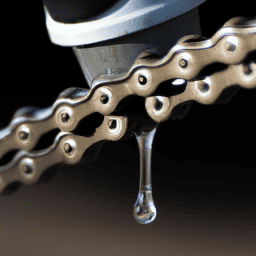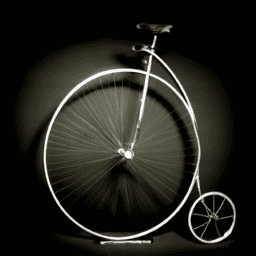Have you ever pondered the reason behind the minimal size of bike saddles? Indeed, they are significantly smaller when measured against other seating varieties. It feels as if one is perched atop a slender, rigid plank made of plastic or leather. It hardly appears to be the coziest spot for prolonged sitting, right?
But there are reasons why bicycle seats are designed the way they are, and it all has to do with weight, wind resistance, and performance. As a cyclist, I’ve spent countless hours sitting on different types of bicycle seats. Some were comfortable, while others were downright painful.
However, I’ve come to appreciate the small size of bicycle seats and the benefits they provide. In this article, I will explain why bicycle seats are so small, the importance of weight and wind resistance, and design considerations that go into creating these seats. So, let’s dive in and explore why bicycle seats are the way they are.
Key Takeaways
- Small bicycle seats help with weight distribution, reducing wind resistance, allowing freedom of movement, and reducing discomfort and chafing.
- When choosing a bicycle seat, it is important to balance comfort and efficiency, consider ergonomic design and anatomical fit, and think about padding and suspension.
- Different types of bicycle seats include leather, synthetic, and carbon fiber, each with their own benefits and drawbacks.
- Smaller bicycle seats have been shown to improve race times for competitive cyclists.
The Importance of Weight and Wind Resistance
You’ll love how riding a bike with a small seat reduces wind resistance and makes it easier to pedal uphill. The small seat has a significant impact on the bike’s overall weight distribution and aerodynamics.
When you’re riding a bicycle, the weight of your body is distributed between the pedals, handlebars, and seat. With a larger seat, the weight of your body shifts towards the back, which can make it harder to maintain balance and control. A smaller seat keeps your weight forward, making it easier to pedal uphill and maintain speed.
In addition to weight distribution, the small seat also has an impact on speed and endurance. A smaller seat reduces wind resistance, allowing you to ride faster with less effort. The aerodynamic design of the seat reduces the amount of drag your body creates, allowing you to ride longer distances with less fatigue.
The combination of weight distribution and aerodynamics makes a small bicycle seat an essential component for any serious cyclist. With a small seat, you’ll have the freedom of movement to ride faster and longer, without sacrificing comfort or control.
Freedom of Movement
Feeling unrestricted and able to move comfortably is essential when riding a bicycle. The freedom of movement allows the rider to pedal with ease and tackle challenging terrain with confidence. It’s no surprise that bicycle seats are small to enable the rider to move freely without any hindrance.
The physical exertion required when cycling is intense, and the rider must use their entire body to power the bike. Having a small, lightweight seat allows the rider to shift their weight quickly and change their position to maximize their output. A small seat also reduces the amount of friction between the rider’s thighs and the seat, which reduces discomfort and chafing.
The freedom of movement provided by a small seat is crucial for any cyclist, whether they are a professional or a casual rider. Transitioning to the next section, while comfort is essential while riding a bicycle, performance should not be sacrificed. Comfortable seats are available on the market that provides the necessary support, but it’s crucial to find a balance between comfort and performance.
Comfort vs. Performance
When it comes to cycling, there’s always a trade-off between comfort and performance.
As a cyclist, I’ve learned that a small seat is worth the discomfort because it allows for more efficient pedaling.
However, it’s important to strike a balance between comfort and efficiency by considering factors such as the role of padding and suspension in reducing discomfort during long rides.
Balancing Comfort and Efficiency
Balancing comfort and efficiency requires finding a seat that allows you to pedal efficiently while also providing enough cushioning for your sit bones. Comfort vs. efficiency is a common debate among cyclists, and the answer lies in finding the right balance.
An ergonomic design is crucial to both comfort and efficiency, as it helps distribute your weight evenly on the seat. This minimizes pressure points and reduces the risk of injury, allowing you to ride longer and harder.
However, it’s important to note that a small seat is often worth the discomfort. While a larger seat may seem more comfortable, it can actually hinder your performance by restricting your leg movement. A smaller seat, on the other hand, allows for a more natural pedaling motion and greater power transfer, ultimately leading to a more efficient ride.
So while it may take some time to adjust to a smaller seat, the benefits in terms of performance make it well worth it in the end.
Why a Small Seat is Worth the Discomfort
You may be hesitant to switch to a smaller seat, but it can greatly improve your cycling performance. A smaller seat allows for a more natural pedaling motion and increased power transfer. In fact, a study of competitive cyclists who made the switch saw significant improvements in their race times. While a larger seat may provide temporary comfort, the long term consequences of a poorly fitting saddle can lead to discomfort, numbness, and even injuries.
Anatomical considerations should also be taken into account when choosing a bicycle seat. A smaller seat can help prevent chafing and rubbing, which can cause discomfort and even open sores. It is important to remember that a smaller seat does not necessarily mean less comfort. With the right fit and proper adjustment, a smaller seat can provide the support and cushioning needed for a comfortable ride. The role of padding and suspension in achieving this comfort will be discussed in the subsequent section.
The Role of Padding and Suspension
Consider adding some cushioning and suspension to your seat to enhance your comfort while riding. When it comes to padding vs. suspension, both options have their benefits.
Padding can provide a softer surface for your sit bones to rest on, while suspension can absorb shocks and vibrations from the road or trail. Ultimately, the choice between padding and suspension will depend on your personal preferences and the type of riding you do.
In terms of material options for padding, there are a few common choices. Gel padding is a popular option as it can conform to your body shape and provide a comfortable ride. Foam padding is another option, which can be lightweight and provide a firmer surface.
When it comes to suspension, some seats may have springs or elastomers to absorb shocks, while others may have a flexible base that can move with your body. By considering these different options, you can find the right combination of padding and suspension to make your ride more comfortable.
Moving on to design considerations, it’s important to also think about the shape and width of your seat.
Design Considerations
As a bike designer, I understand the importance of seat size in relation to overall bike design. The size and shape of the seat can have a significant impact on the geometry of the frame and the handling and stability of the bike.
For example, a larger seat may require a taller frame, which can affect the bike’s center of gravity and maneuverability. It’s important to carefully consider the relationship between the seat and frame in order to achieve optimal performance and comfort.
How Seat Size Affects Bike Design
When you hop on a bike, you’ll notice how the small seat affects the overall design of the bicycle, making it more streamlined and aerodynamic for faster speeds. This is because the size of the seat directly impacts the relationship between the rider and the bike, as well as the balance and weight distribution of the entire bike. When designing a bicycle, the size and shape of the seat are carefully considered alongside other factors such as the frame geometry, wheel size, and handlebar position.
To better understand the impact of seat size on bike design, let’s explore some of the key factors that are taken into account by designers. The following table provides an overview of different seat materials and their pros and cons, as well as some ergonomic considerations that influence seat design.
| Seat Material | Pros | Cons | Ergonomic Considerations |
|---|---|---|---|
| Leather | Comfortable, breathable, molds to rider | Requires maintenance, can be expensive | Shape and padding to prevent pressure points |
| Synthetic | Durable, weather-resistant, low maintenance | Can be less comfortable, less breathable | Shape and padding to prevent pressure points |
| Carbon Fiber | Lightweight, strong, customizable | Expensive, can be stiff | Shape and padding for comfort and support |
As you can see, the choice of seat material depends on a number of factors, including the rider’s preferences and the intended use of the bike. However, regardless of the material chosen, designers must also consider the ergonomics of the seat to ensure that it provides the necessary support and comfort for the rider.
The relationship between seat and frame is crucial to the overall design of a bike. Without a properly sized and positioned seat, a rider may experience discomfort, fatigue, or reduced performance. In the next section, we will explore how the size and shape of the seat impact the relationship between the rider and the frame of the bike.
The Relationship Between Seat and Frame
To truly understand the impact of seat size on a bike’s design, you need to experience how the relationship between the seat and frame affects your comfort and performance as a rider.
Seat and frame compatibility is essential for ergonomic design. A seat that is too wide or narrow for the frame can cause discomfort, pain, and even injury. Furthermore, a poorly designed seat can hinder your ability to pedal, shift gears, and control the bike. Therefore, selecting the right seat size is crucial for optimizing your riding experience.
The impact of seat size on handling and stability is significant. A seat that is too high or low can affect your center of gravity, making it more challenging to balance and control the bike. Additionally, a seat that is too far forward or back can affect the bike’s weight distribution, making it more difficult to maneuver through turns or handle sudden obstacles.
Therefore, bike manufacturers use precise measurements and calculations to ensure that the seat’s position and size complement the frame’s geometry, resulting in a bike that is comfortable, efficient, and stable.
The Impact on Handling and Stability
Imagine yourself riding a bike with a seat that is too high or low, causing you to struggle with balance and control as you navigate through turns and obstacles. The size of a bicycle seat plays a crucial role in your overall riding experience by impacting your posture, balance, and stability. A small seat allows for greater freedom of movement, which can help you easily change your body position and maneuver through turns. However, this can also put more pressure on your sit bones and potentially lead to discomfort or pain over time.
Moreover, gender differences can also affect the sizing and shape of bicycle seats. Women tend to have wider hips and a different pelvic structure compared to men, which means they may require a wider or differently shaped seat to accommodate their anatomical differences. These factors must be taken into consideration when choosing the right seat to ensure optimal comfort and performance. In the following section, we will explore how to find the right seat for your individual needs.
Finding the Right Seat
When it comes to finding the right seat for my bicycle, there are several factors I always consider. First and foremost, proper fit is crucial for both comfort and performance.
I also take into account the type of riding I’ll be doing, as different seats are designed for different types of cycling.
Finally, I’ve learned some tips for maximizing comfort on longer rides, such as adjusting the angle and height of the seat.
Factors to Consider When Choosing a Seat
You gotta think about your butt, dude! Ain’t nobody want an uncomfortable ride, so make sure you pick a bicycle seat that fits your body and riding style.
When choosing a seat, there are several factors to consider. Firstly, seat shape is crucial in determining comfort. There are various shapes available, including narrow and wide, with each catering to different body types. It is essential to choose a seat that matches your body shape and provides enough support.
Secondly, material selection plays a vital role in determining comfort. Bicycle seats are made from different materials, including leather, foam, and gel. Each material has its advantages and disadvantages, and it’s essential to select a material that aligns with your riding style. For example, a leather seat is durable but may not provide enough cushioning for long rides, while a gel seat may offer more cushioning but may not be as durable as a foam seat.
Lastly, consider the padding of the seat. A seat with too much padding may cause discomfort, while a seat with too little padding may cause pain. It’s essential to find a balance that fits your riding style and body shape.
In conclusion, choosing the right bicycle seat is crucial in ensuring a comfortable ride. The next section will delve into the importance of proper fit in selecting a bicycle seat.
The Importance of Proper Fit
To ensure a comfortable ride, it’s crucial to make sure your seat fits your body properly. A poorly fitting seat can cause discomfort and even lead to injuries. Proper fit is especially important in preventing saddle-related injuries such as chafing, numbness, and pressure sores.
The key to proper fit is finding the right width and shape for your body. You want a seat that supports your sit bones (ischial tuberosities) and doesn’t put pressure on soft tissue. A good rule of thumb is that your sit bones should be on the widest part of the seat.
Don’t be afraid to experiment with different seats until you find one that feels right. Remember, a comfortable seat can make all the difference in your cycling experience.
Now, let’s move on to some tips for maximizing comfort and performance.
Tips for Maximizing Comfort and Performance
If you want to get the most out of your ride, it’s important to focus on proper hydration and nutrition. But another factor that can greatly affect your cycling experience is your bike’s saddle. To maximize your comfort and performance, it’s important to pay attention to proper posture, cushioning, and adjusting the height of your saddle.
Proper posture is key to avoiding discomfort or injury. Keep your back straight and your shoulders relaxed. Avoid slouching forward or leaning too far back. Your saddle should also have enough cushioning to prevent pain or numbness, but not so much that it interferes with your ability to pedal efficiently. Adjusting the height of your saddle is also important to ensure that your legs are properly aligned and can generate maximum power. A good rule of thumb is to adjust the saddle so that your knee is slightly bent when the pedal is at its lowest point. By paying attention to these details, you can make your cycling experience more enjoyable and effective.
| Advantages | Disadvantages |
|---|---|
| More cushioning | Less efficient pedaling |
| Easy adjustment | Can cause discomfort in long rides |
| Suitable for beginners | Not ideal for high-speed cycling |
| Provides relief for pressure points | May affect balance and stability |
| Versatile for different types of rides | May add weight to the bike |
As you can see, choosing the right saddle can greatly impact your cycling experience. By considering factors such as proper posture, cushioning, and height adjustment, you can find a saddle that provides both comfort and performance. Use the table above as a reference when making your decision, and don’t be afraid to try out different options until you find the perfect fit.
Frequently Asked Questions
Do smaller bike seats affect male anatomy?
Smaller bike seats can negatively impact male anatomy due to increased pressure on the perineum. Bike seat design has evolved to incorporate comfort solutions such as cutouts, padding, and varying widths to alleviate discomfort.
Are there any health risks associated with small bike seats?
I investigated whether small bike seats pose health risks. Bike seat design and the importance of proper bike fit play a crucial role in preventing discomfort and injury. Technical knowledge is necessary to ensure a safe and comfortable ride.
Why do some professional cyclists prefer smaller seats despite the discomfort?
As a professional cyclist, I can attest that seat size preference is crucial to performance. Despite the discomfort, smaller seats offer greater control and power transfer, allowing for more efficient pedaling and faster speeds.
Are there any alternatives to small bike seats for long distance cycling?
When it comes to long distance cycling, comfortable alternatives to small bike seats include wider seats with adequate padding. The importance of padding cannot be overstated, as it reduces pressure on the sit bones and helps prevent numbness and pain.
Can adjusting the seat height or angle help with discomfort on small bike seats?
Adjusting seat height or angle can alleviate discomfort on small bike seats, but seat cushioning and padded shorts are more effective solutions. Proper bike fit and posture also play important roles in reducing discomfort.
Conclusion
In conclusion, after diving deep into the world of bicycle seats, it’s clear that their small size is not just a design choice but a necessity for performance and comfort. The importance of weight and wind resistance cannot be overstated, and a larger seat would compromise both of these crucial factors. Additionally, the freedom of movement provided by a smaller seat allows for a more efficient pedal stroke and overall cycling experience.
However, it’s essential to note that finding the right seat is crucial for both comfort and performance. Design considerations like padding, shape, and materials must all be taken into account to ensure a comfortable ride.
In the end, the small size of bicycle seats may seem counterintuitive, but it’s a carefully considered choice that allows for optimal performance and comfort on the road. As the saying goes, ‘small but mighty.’ Bicycle seats may be small, but their impact on a cyclist’s ride is significant.
By understanding the importance of weight and wind resistance, the freedom of movement, and the design considerations that go into creating the perfect seat, cyclists can appreciate the small but mighty nature of their trusty saddle.
